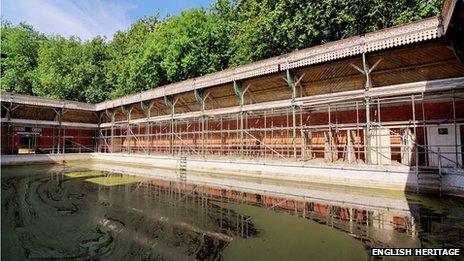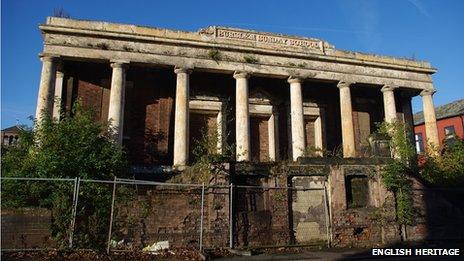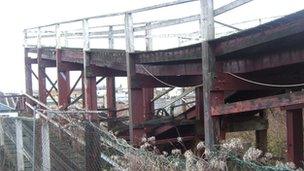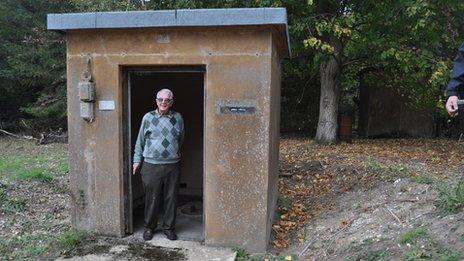The battle to save England's heritage
- Published
Across England, thousands of listed buildings are at risk from neglect, decay and damaging alterations.
English Heritage (EH) has already tried to identify those Grade I and Grade II* buildings most in danger through its Heritage at Risk Register which was launched in 1998.
But from Friday, Grade II buildings, which make up 92% of listed buildings, will be added to the list for the first time in an effort to galvanise support for restoration projects.
BBC News looks at some of those already on the list and some Grade II buildings identified as being at risk.
The women only swimming pool

King's Meadow Baths was briefly used by a dive school
King's Meadow Baths opened in 1903 as a women's only facility to allow them to bath in private.
The Grade II listed building ceased operating as a public pool in 1974, although it was used by a dive school for a period up until the mid-2000s.
Developers Askett Hawk proposed restoring the lido and building a hotel alongside it in 2009, but the application was rejected by Reading Council over doubts whether "planning issues" could be overcome.
Instead, councillors gave campaigners the chance to raise their own funds to reopen the pool themselves.
Bob O'Neill, from the King's Meadow Trust Campaign, admitted raising the £1.5m needed has been tough but he still thinks it is feasible.
"I think it's very realistic [to reopen the lido], there were times in the summer we could have had that building thriving with people in it."
The pottery works with its own Sunday school

The school was built for the pottery workers' children
The Wade Heath Pottery building in Burslem, Stoke-on-Trent, was used by Wade Heath and Company from 1954 to 2010, but now stands empty.
The Wade Group of Potteries, which started in 1810, later merged with several potteries to become George Wade & Son Ltd and in the 1950s produced the ceramic Whimsie animal series that was popular in both the UK and America.
Next to the pottery works is Hill Top Sunday School, which was built as a Methodist Sunday school in 1836 for the workers' children.
It closed in 1977 and in 1983 a fire damaged the main body of the building, which was later demolished, leaving only a front portico.
Both the pottery works building and the school are grade II listed.
Dave Chetwyn, planning adviser with the Potteries Heritage Society (Stoke-on-Trent's Civic Society), said that Burslem is one of the "highest quality historic environments" in the city and that the two buildings need to be incorporated into any new development.
He said: "Stoke doesn't have that many listed buildings, it's got far below average, but we know that heritage can be a very powerful tool, its been used by towns and cities all around the UK as a means to regenerating the area."
The listed rollercoaster

The ride, which was damaged in an arson attack in 2008, has been upgraded from Grade II listed status
Britain's oldest rollercoaster thrilled visitors to Dreamland amusement park, in Margate, Kent, for more than 80 years from its opening in the 1920s to its closure in 2006.
The timber structure and trains with manually-operated brakes proved a huge draw post-war and in the 1980s and 90s but after its closure it fell into disrepair and was damaged by fire in 2008.
The disused ride became a sad reminder of the resort's heyday, but it looks set to run again after Thanet Council was given the go-ahead to buy the park and restore the historic structure.
Nick Laister, chairman of site operator The Dreamland Trust, said: "Local people love it because it's such a part of Margate's history but it's pretty much well-known across the whole of the south east of London."
Plans for the restoration include replacing timbers and the two trains lost in the fire plus installing an automated safety cut out system.
Mr Laister said: "It's the last one of its kind in the UK, if that's lost there's no more."
The nuclear bomb store

Keith Eldred with one of the 57 "kiosks" where nuclear devices were stored
A secret Ministry of Defence site at Barnham in Suffolk, was where Britain's independent nuclear weapons were kept from 1953 until it became obsolete in 1959.
The 27 acre (9 hectare) site was sold by the Ministry of Defence in 1966 and is currently the Gorse Industrial Estate, external, and some of the buildings are rented to businesses.
The rest of it - the five watchtowers, concrete perimeter wall, 57 concrete 'kiosks' (which stored the nuclear warheads) and other testing and maintenance buildings - have deteriorated and the 'scheduled monument' has now been put on the at-risk register by English Heritage.
About £90,000 is already spent each year on conservation work and one watchtower was fully restored for £40,000.
John Ette, inspector of monuments for English Heritage, said: "There's an ongoing programme or repairs that are still desperately needed before it can come off the at-risk register - we haven't even started on the kiosks yet."
The site owner, Keith Eldred, funds about 20% of the work.
He said: "The site has suffered from metal theft, but we've alarmed all the main buildings, we've got security cameras and the fence around it is getting more secure, so the last year has not been too much of a problem.
"Hopefully, when we finish the project, it will be open on English Heritage Day and eventually we will have a little museum and it'll be very useful for schools."
- Published12 October 2012
- Published17 August 2012
- Published20 October 2010
- Published12 October 2010